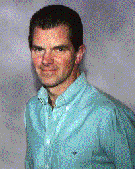


about theory
meetings
people
projects
publications
review
home
 |
Daren Stotler Office: C-Site A131 Phone: (609) 243-2063 email: dstotler@pppl.gov webpage: https://w3.pppl.gov/~dstotler research interest: DEGAS 2 |
|
Dr. Daren Stotler is a Principal Research Physicist in the Theory Department primarily interested in the interaction between plasmas and their material surroundings. In an experiment or reactor, those interactions result in the release of atoms and molecules into the plasma. These electrically neutral particles can freely cross the magnetic field lines of the experiment, perhaps resulting in a deterioration of its performance. Dr. Stotler has worked with Dr. Charles Karney to develop the DEGAS 2 neutral gas code to study how the plasma-material interactions and the resulting particles affect current experiments and predict their impact on future devices.
Dr. Stotler has exploited the flexibility and parallelization capability designed into DEGAS 2 to simulate in detail neutral particle transport in experiments carried out on the Alcator C-Mod tokamak at MIT and the National Spherical Torus Experiment (NSTX) at PPPL. This work includes detailed three-dimensional DEGAS 2 simulations of NSTX Gas Puff Imaging turbulence visualization experiments that match the experimental observations to within the estimated errors. Most recently Dr. Stotler has been leading PPPL's participation in the Center for Plasma Edge Simulation [CPES; C. S. Chang (NYU), P. I.]. Stotler is developing a 3-D comprehensive neutral particle transport routine based on DEGAS 2 that can be integrated into the CPES kinetic plasma simulation code. At the heart of all of these efforts is a keen interest in code verification and validation ("V&V"); Dr. Stotler is currently serving on the U.S. Burning Plasma Organization Verification and Validation Task Group formed to bring greater attention to the need for careful V&V. Dr. Stotler also has significant experience with simulating the plasma response of the plasma to these neutral particles using codes such as B2 (written by Dr. B.J. Braams of NYU) and UEDGE (provided by Dr. T.R. Rognlien of LLNL). Prior to working on the plasma-material interaction problem, Dr. Stotler studied transport and confinement of the main (core) plasma, particularly with regard to reactor design. In addition to contributing to the development of the BALDUR predictive transport code, he wrote three global (i.e., considering the plasma to be uniform) analysis codes, including the ASPECT code which is still in use. The relatively simple formalism underlying these global analysis codes led Dr. Stotler to write two Virtual Tokamak applets as part of the Internet Plasma Physics eXperience (IPPEX) science education effort. The original, steady state Virtual Tokamak has proven to be a very effective tool for communicating the physics of fusion reactors to students of all ages and has even been translated into other languages. Dr. Stotler also has significant involvement in the New Jersey Regional Science Bowl and New Jersey State Science Olympiad contests for high school students. Dr. Stotler's publication record contains more than 85 papers in refereed journals or conference proceedings. He received his Ph.D. in Applied Physics from the University of Texas at Austin in 1986. He received a B.A. summa cum laude from Rice University in 1981 with a double major in physics and materials science. He was a member of the Phi Beta Kappa (nominated in the fall of 1980), Sigma Pi Sigma, and Tau Beta Pi honor societies. Named a Max Roy scholar, he was awarded academic scholarships by the Brown Engineering Development Committee, the Champlin Petroleum Corporation, and the Beta Sigma Phi sorority. |
|
about theory | meetings | people | projects | publications | review | home
all content © Princeton Plasma Physics Laboratory